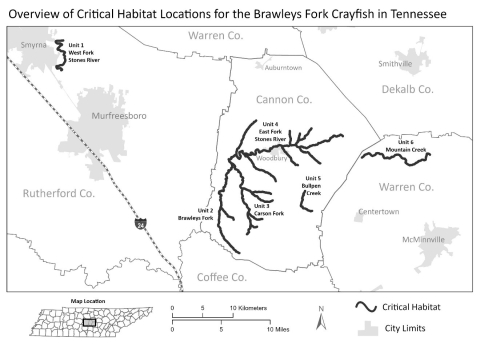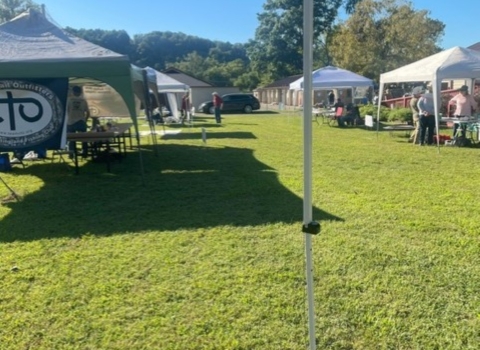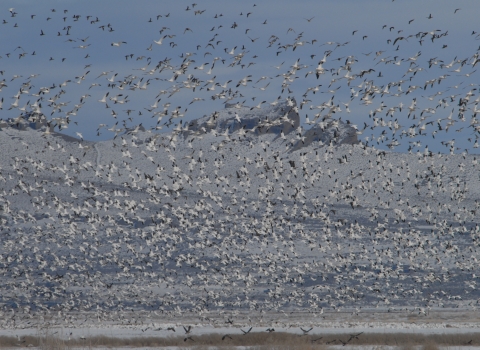What is the Brawleys Fork crayfish?
The Brawleys Fork crayfish (Cambarus williami) is a small, freshwater crayfish endemic to the Nashville Basin and Eastern Highland Rim ecoregions of central Tennessee.
Where does the Brawleys Fork crayfish occur?
Brawleys Fork crayfish is known to occur in 20 streams in five watersheds within its range in Cannon, Warren, and Rutherford counties, Tennessee. It occurs primarily in small- to medium-sized streams of the Stones and Collins river systems. Brawleys Fork crayfish typically occupies runs and riffles with moderate to fast flow and layered cherty gravel and cobble substrate with ample interstitial space not consolidated by fine substrates such as silt.
What action is the U.S. Fish and Wildlife Service proposing?
The Service is proposing to list the Brawleys Fork crayfish as threatened under the Endangered Species Act (ESA) with a rule under section 4(d) that tailors protections for the species. Approximately 86.6 river miles (rmi) (139.4 river kilometers) (rkm) in six units in Tennessee are also being proposed for designation as critical habitat for the species. The Service is seeking comments on these proposed actions and accompanying documents.
What are the threats to the Brawleys Fork crayfish?
The primary driver of the current and future condition of the Brawleys Fork crayfish is habitat loss and degradation due to sedimentation and water quality from sources including agricultural practices, horticultural practices, and urbanization; and instream modification including impoundments, gravel dredging, and channel alteration. Each of the threats influencing Brawleys Fork crayfish viability may be further exacerbated by the effects of small, isolated populations and the future effects of climate change climate change
Climate change includes both global warming driven by human-induced emissions of greenhouse gases and the resulting large-scale shifts in weather patterns. Though there have been previous periods of climatic change, since the mid-20th century humans have had an unprecedented impact on Earth's climate system and caused change on a global scale.
Learn more about climate change .
What is a 4(d) rule?
For a threatened species, the Service may use the flexibility provided under the ESA’s Section 4(d) to tailor take prohibitions to those that provide conservation benefits for the species – referred to as a 4(d) rule. The ESA allows for 4(d) rules that are “necessary and advisable” for the conservation of the species. This targeted approach can reduce ESA conflicts by allowing some activities to continue that may benefit and not significantly harm the crayfish, while focusing efforts on the threats that slow the species’ recovery. These customized protections of the ESA minimize the regulatory burden while maximizing the likelihood of recovery for threatened species.
Under the proposed 4(d) rule, prohibitions and exceptions to prohibitions that typically apply to endangered wildlife will also apply to the Brawleys Fork crayfish. The Service’s proposed 4(d) rule provides exceptions to incidental take prohibitions to accommodate permitted activities and other exceptions. These include channel restoration projects that create natural, physically stable, ecologically functioning streams; bank stabilization projects; and bridge and culvert replacements and low head dam removals. It would also except incidental take resulting from transportation projects that provide fish passage fish passage
Fish passage is the ability of fish or other aquatic species to move freely throughout their life to find food, reproduce, and complete their natural migration cycles. Millions of barriers to fish passage across the country are fragmenting habitat and leading to species declines. The U.S. Fish and Wildlife Service's National Fish Passage Program is working to reconnect watersheds to benefit both wildlife and people.
Learn more about fish passage at stream crossings.
How does the ESA define critical habitat?
The ESA defines critical habitat as the specific geographic areas that contain features essential to the conservation of an endangered or threatened species and that may require special management and protection. Critical habitat may also include areas that are not currently occupied by the species but will be needed for its recovery.
How does the Service determine what areas to designate as critical habitat?
Within areas occupied by the species, biologists consider physical or biological features needed for life processes. These include:
Space for individual and population growth and for normal behavior.
Cover or shelter.
Food, water, air, light, minerals, or other nutritional or physiological requirements.
Sites for breeding and rearing offspring.
Habitats that are protected from disturbances or are representative of the historical, geographical, and ecological distributions of a species.
After considering occupied areas, biologists consider unoccupied areas that may be essential for the conservation of the species.
What is the proposed critical habitat for the Brawleys Fork crayfish?
The proposed critical habitat for the Brawleys Fork crayfish is located in Cannon, Warren, and Rutherford counties, Tennessee, and consists of approximately 86.6 rmi (139.4 rkm) of occupied habitat in six critical habitat units. All proposed critical habitat units are currently occupied by the Brawleys Fork crayfish.
The riparian riparian
Definition of riparian habitat or riparian areas.
Learn more about riparian lands adjacent to the areas proposed as critical habitat include lands in private (91 percent), Federal (7.2 percent), and State or local ownership (1.8 percent). All proposed units have at least four of the five physical or biological features essential to the conservation of the Brawleys Fork crayfish and are of a sufficient size to support translocation or augmentation of crayfish populations. The proposed critical habitat does not overlap with any other proposed or designated critical habitat, and no other listed species co-occur in the proposed units.
Unit/Subunit Number | Unit Name (# of subunits) | Private (rmi) | Federal (rmi) | State or Local (rmi) | Total River Miles |
1 | West Fork Stones River |
| 6.2 |
| 6.2 |
2 | Brawleys Fork | 13.8 |
|
| 13.8 |
Unit 3 – Carson Fork | |||||
3a | Carson Fork | 12.3 |
|
| 12.3 |
3b | Haws Spring Fork | 5.9 |
|
| 5.9 |
Unit 4 – East Fork Stones River | |||||
4a | East Fork Stones | 30.9 |
| 1.6 | 32.5 |
4b | Rockhouse Creek | 3.4 |
|
| 3.4 |
5 | Bullpen Creek | 3.1 |
|
| 3.1 |
6 | Mountain Creek | 9.4 |
|
| 9.4 |
Total | 78.8 | 6.2 | 1.6 | 86.6 |
What are the physical or biological features are essential to the conservation of the Brawleys Fork crayfish?
They are:
Moderate to fast-flowing stream with unembedded cherty-gravel and cobble substrate within an unobstructed stream continuum (i.e., riffle, run, pool complexes) of perennial, small- to moderate-sized (generally third order or smaller) streams and rivers (up to the ordinary high-water mark as defined at 33 CFR 329.11).
Stream banks with intact riparian cover to maintain stream morphology and reduce erosion and sediment inputs that may reduce availability of substrate interstitial spaces.
Water quality characterized by seasonally moderated, or spring influenced, water temperatures and physical and chemical parameters (e.g., pH, conductivity, dissolved oxygen) sufficient for the normal behavior, growth, reproduction, and viability of all life stages.
Adequate food base, indicated by a healthy aquatic community structure structure
Something temporarily or permanently constructed, built, or placed; and constructed of natural or manufactured parts including, but not limited to, a building, shed, cabin, porch, bridge, walkway, stair steps, sign, landing, platform, dock, rack, fence, telecommunication device, antennae, fish cleaning table, satellite dish/mount, or well head.
Learn more about structure including native benthic macroinvertebrates, fishes, and plant matter (e.g., leaf litter, algae, detritus).An interconnected network of streams and rivers that have the physical and biological features described in (1) through (4), above, that allow for the movement of individual crayfish in response to environmental, physiological, or behavioral drivers, and promote resiliency. The scale of the interconnected stream network should be sufficient to allow for gene flow within and among watersheds and promote representation (the ability of the species to adapt to both near-term and long-term changes in its physical and biological environments).
What is the draft economic analysis on this proposed action and why was it done? What did it find?
Draft economic analyses (DEA) are created to analyze the economic impacts of a proposed critical habitat designation. The DEA for the Brawleys Fork crayfish found that the economic cost of implementing the rule will likely be limited to additional administrative effort in considering adverse modification of the species' habitat during section 7 consultations.
How do I submit comments on this proposal?
For directions on how to submit comments, visit the Federal eRulemaking Portal at http://www.regulations.gov. In the Search box, enter FWS-R4-ES-2023-0065, which is the docket number for this rulemaking. Comments must be received by October 23, 2023. We must receive requests for a public hearing, in writing, at the address shown below by October 6, 2023.
FOR FURTHER INFORMATION CONTACT: Daniel Elbert, Field Supervisor, U.S. Fish and Wildlife Service, Tennessee Ecological Services Field Office, 446 Neal Street, Cookeville, TN 38501-4027; telephone 931-254-9617. Individuals in the United States who are deaf, deafblind, hard of hearing, or have a speech disability may dial 711 (TTY, TDD, or TeleBraille) to access telecommunications relay services. Individuals outside the United States should use the relay services offered within their country to make international calls to the point-of-contact in the United States.
What information is the Service requesting?
The Service intends that any final action resulting from this proposed rule will be based on the best scientific and commercial data available and be as accurate and as effective as possible. Therefore, we are requesting comments or information from other concerned governmental agencies, Native American tribes, the scientific community, industry, or any other interested parties.
The Service is particularly seeking comments concerning:
The species’ biology, range, and population trends.
Factors that may affect the continued existence of the species.
Biological, commercial trade, or other relevant data concerning any threats.
Additional information concerning the historical and current status, range, distribution, and population size of this species, including the locations of any additional populations of this species.
Information on regulations that are necessary and advisable to provide for the conservation of the Brawleys Fork crayfish that the Service can consider in developing a 4(d) rule for the species.
Submissions merely stating support for or opposition to the proposed rule, while noted, will not be considered in making a determination.


